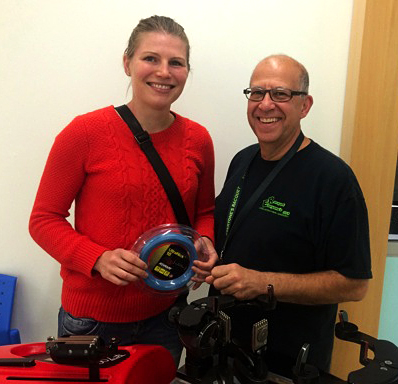|
|

Trends in Stringing I: Habits of the Pros
By Steve Crandall
Vice President, Sales & Marketing
Ashaway Racket Strings

Line Hansen and tournament stringer Joe Falzone at the 2014 US Open in Philadelphia. |
Of all the questions I get from players, the most frequent are those relating to the stringing habits of the pros. People want to know what strings they use, how often they string, what tensions they string to, how many rackets they play with, whether they use the same stringer all the time, etc., etc. Of course, there is no single answer to any one of these questions: professionals are as varied in their string choice and habits as other players.
That said, there are a few 'string things' professionals do have in common that distinguish them from amateur players. First, they are more conscious of string and how it affects their game, and are generally more knowledgeable about it. Second, they are much more likely to have experimented with different string types and tensions in a systematic manner, and know what works for them. Third, they are much more likely to be consistent in their stringing habits to keep their rackets (generally several) in tip-top form.
Also, among the many pros who use Ashaway string, we have noticed that an increasing number are using Zyex®-based strings like PowerNick® and UltraNick®, as opposed to the Nylon-based SuperNick® XL strings.
Now we can't claim to have documented this trend scientifically, but it is supported both anecdotally and by information we have been able to gather. We've been fortunate to be the "Official String and Stringer" for a number of recent high profile tournaments in the UK, working with our partner, Goode Sport, and their records show a decided slant in favor of the Zyex-based strings. For instance, in the 2012 British Open, Goode Sport strung over 100 rackets, over 75% of which were strung with Ashaway string. Of those, another 75% were strung with either a PowerNick or UltraNick, both Zyex-based lines.
In the 2012 British Grand Prix, the numbers were even better: fully 50% of the Ashaway string chosen was PowerNick 18 and over 80% was Zyex-based, against 20% nylon. Average stringing tension at that tournament was 26 lbs. for Zyex vs. 28 for the SuperNicks.
These same numbers held for the 2013 World Championships when, again, 75% of the rackets were strung with Ashaway string. This also appeared to be the case at the recent US Open, although we don't have actual numbers to support it.
Admittedly, we cannot say these numbers are representative of all professional string usage. Many professionals have their rackets strung by their own stringer, or string themselves before they come to a tournament. However, as many will have a racket restrung at a tournament when they break a string, we think it is safe to at least say the pros are moving towards Zyex-based strings.
Why is this? We believe, simply, that Zyex is a superior material for string for professional use, even though our nylon SuperNick models are also quite popular on tour. Tests have shown that Zyex is more durable, generates more power, and holds tension better than nylon. Nylon is less expensive, but better tension holding means Zyex-based string lasts longer. Players who use Zyex also say it offers more touch than nylon and is more comfortable on the arm. We talked to three such pros at the US Open. Here's what they had to say.
Denmark's Line Hansen has been on the pro circuit since 2001 and is currently ranked 25 by the WSA. She strings her own rackets at home, but will restring at a tournament if one breaks. "I'm not that fussy compared with a lot of other players," she said. "I'm happy as long as it's strung around 28 Lbs." Line says she likes to hit the ball "hard and flat," and switched to the Zyex-based UltraNick 18 two years ago. The string, she says, gives her "a bit more 'touch' compared to a lot of other strings."
French up-and-comer Mathieu Castagnet is currently ranked 15 by the PSA, and just won the Montreal Open with a truly "Ironman" performance, playing 17 games over four matches with an average time of 22-minute per game. Mathieu uses Ashaway PowerNick 18, strung at a tight 28 to 29 Lbs. He told me he likes the Zyex-based string, "because it doesn't lose tension and it doesn't break easily." He said it is also, "quite comfortable and I can feel the ball for my drops and volleys." He usually brings four rackets to a tournament but tries to play the same racket. "I can trust the string, and use the same racket for several matches and sometimes the entire tournament."
We also spoke to three time World Champion and 2013 PSA Player of the Year, Britain's Nick Matthew, who also likes the performance he gets from PowerNick 18. Like many top pros, Nick is very particular in his stringing habits, telling me he had, "been successful in the business long enough to know what works" for his game! Nick uses only the stringer at his home club and brings no fewer than six freshly strung rackets with him to tournaments, strung at precisely 27 Lbs. And his attention to stringing detail certainly pays off as evidenced by his long and successful career!
ZYEX® is a registered trademark of Victrex Ltd.
This article previously appeared in Squash Magazine.
|